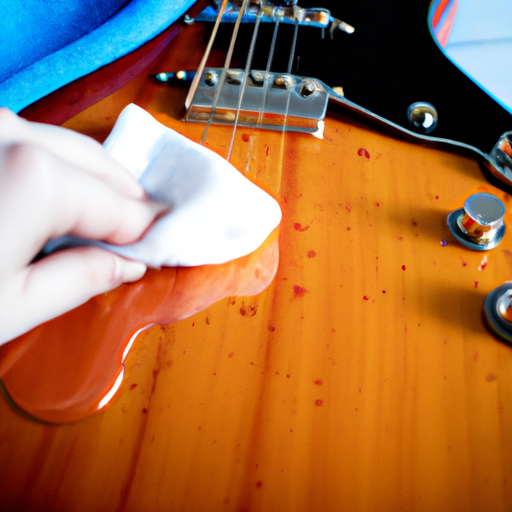
If you're a beginner guitarist, you might not be aware of the importance of guitar care. Proper maintenance not only ensures that your guitar looks good, but it also prolongs its lifespan and keeps it sounding great. In this article, we'll cover everything you need to know about guitar maintenance and care.

The first step to maintaining your guitar is to keep it clean. Here's how:

Use a soft cloth to wipe down the body of your guitar. Avoid using harsh chemicals or abrasive materials that could scratch the finish. For tough stains or grime, use a guitar cleaner specifically designed for your guitar's finish.
The fretboard is where your fingers come into contact with the guitar, so it's important to keep it clean. Use a slightly damp cloth to wipe down the fretboard, being careful not to get water on the frets. For extra cleaning power, use a fretboard cleaner and conditioner.
Old strings can sound dull and lifeless, so it's important to keep them clean. Use a soft cloth to wipe down the strings after each use. You can also use a string cleaner to remove dirt and grime.
Proper storage is key to keeping your guitar in good shape. Here's what you need to know:
Store your guitar in a cool, dry place where it won't be exposed to direct sunlight or extreme temperatures. Avoid storing it in a damp basement or garage where humidity levels can fluctuate.
A guitar case provides protection from dust, dirt, and scratches. It also helps regulate temperature and humidity levels, which can affect the guitar's tone and playability. Invest in a high-quality guitar case that fits your guitar snugly.
Guitars are sensitive to changes in temperature and humidity. Extreme heat or cold can cause the wood to warp or crack, while high humidity can cause the strings to rust. Use a hygrometer to monitor humidity levels and a room thermometer to monitor temperature.
Regularly changing your guitar strings can improve the sound and playability of your instrument. Here's what you need to know:
Most guitar strings need to be changed every 3-6 months, depending on how often you play. If your strings sound dull or have become difficult to tune, it's time for a change.
Changing guitar strings can be intimidating for beginners, but it's actually quite simple. Follow these steps:
There are many different types of guitar strings available, each with its own unique sound and feel. Experiment with different gauges and materials to find the strings that work best for you.
Tuning your guitar is essential for good sound and playability. Here's what you need to know:
You can tune your guitar using an electronic tuner, a tuning app on your phone, or by ear. The most common tuning is standard EADGBE tuning, but there are many other tunings to explore.
A guitar that is out of tune will sound bad and be difficult to play. Always tune your guitar before playing.
Invest in a good quality tuner or tuning app to ensure accurate tuning. You can also use a pitch pipe or tuning fork.
The truss rod is a metal rod that runs through the neck of the guitar. It allows you to adjust the curvature of the neck to ensure proper string height and playability. Here's what you need to know:
The truss rod counteracts the tension of the strings and helps keep the neck straight.
If your guitar's action is too high or too low, you may need to adjust the truss rod. This should only be done by an experienced guitar technician.
Adjusting the truss rod involves turning a small nut at the base of the neck with an Allen wrench. Turn the nut clockwise to tighten the rod and straighten the neck, and counterclockwise to loosen the rod and allow the neck to bow slightly.
Proper handling of your guitar can prevent damage and prolong its lifespan. Here's what you need to know:
Always support the neck of the guitar with your left hand when playing or carrying it. Avoid bumping it into walls or furniture.
Mishandling your guitar can cause damage to the neck, body, or electronics. Always be mindful of how you're handling your guitar.
The finish of your guitar can be easily scratched or damaged. Here's what you need to know:
Avoid resting your guitar against hard surfaces or wearing clothing with metal buttons or zippers that could scratch the finish. Use a soft cloth to wipe down the finish regularly.
For minor scratches, use a guitar polish or scratch remover. For deeper scratches or scuffs, consult an experienced guitar technician.
The electronic components of your guitar, such as the pickups and volume controls, need to be maintained to ensure proper functioning. Here's what you need to know:
Use a soft cloth to wipe down the electronics and remove any dust or dirt. If your guitar has scratchy or noisy electronics, consult an experienced guitar technician.
If your guitar has issues such as low output or noisy electronics, it may need to be rewired or have its components replaced. Consult an experienced guitar technician for repairs.
Maintaining your guitar is essential for ensuring good sound and playability. Follow the tips in this article to keep your guitar in top shape. Remember, a well-cared-for guitar will last a lifetime.
Click here for more information on guitar care and rental services.